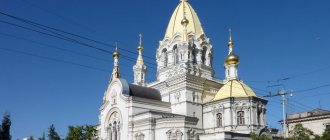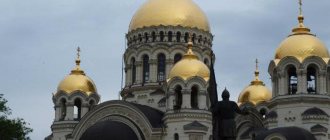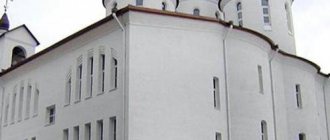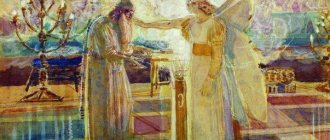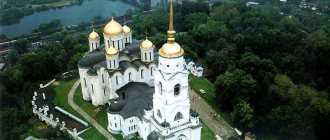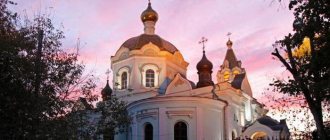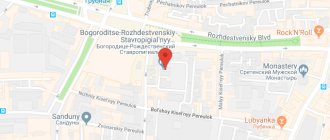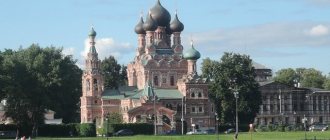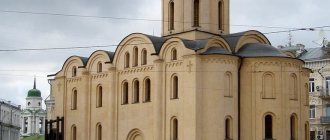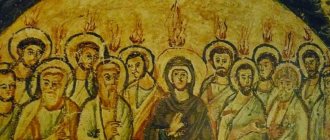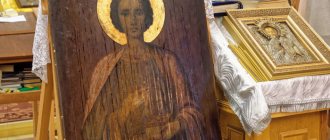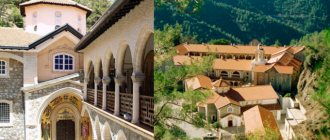| Bell tower of Ivan the Great, Assumption belfry and Filaret's extension in the Moscow Kremlin |
The Bell Tower of Ivan the Great
or
the Bell Tower “Ivan the Great”
, the commonly used name
of the Moscow Kremlin church-bell tower in the name of St. John Climacus
of the Moscow Diocese
- Throne: St. John Climacus
- Address: Russia, Moscow, Kremlin, Cathedral Square
- On the map: Yandex.Map, Google map
It is located between the Cathedral and Ivanovskaya (Tsarskaya) squares of the Moscow Kremlin and is its compositional center. The church-bell tower is almost closely adjacent to the Assumption Belfry from the south with the Filaret extension, together forming a single architectural ensemble. The Church of St. Nicholas of Gostunsky, located in the Assumption Belfry, is now listed as the chapel of the bell church of St. John the Climacus.
First Temple
The first information about the existence of a throne in the name of St. John Climacus in the sacred topography of Moscow dates back to 1329. Chronicles report the foundation of a stone church and its subsequent consecration:
In the summer of 6837, the month of Maya at 21, in memory of the holy orthodox Tsar Kostyantin and his mother Helen, a stone church was founded in Moscow, in the name of St. Ivan the Climacus. The same summer was celebrated and sacred in the month [September] at 1, in memory of the holy father Simeon the Stylite
[1].
The chronicle's report about the construction of the temple in three months suggests that the church was small in size [2]. Presumably this was the first Moscow church consecrated in the name of St. John Climacus. Among the numerous attempts to explain the choice of dedication, the versions that remain relevant are that the temple was built according to a vow after a successful bloodless campaign against Pskov, where the Tver prince Alexander Mikhailovich was hiding [3] and that the Monk John Climacus was the heavenly patron of the middle son of the Grand Duke John Kalita - Grand Duke John Ioannovich, who was born on the day of memory of this saint [4].
In 1346 the temple was painted. In the same year, “Master Borisko poured three large bells and two small ones” [5]; according to the Nikon Chronicle, the master had the nickname Roman, which may indicate his origin.
In 1475, sarcophagi with the relics of saints from the dismantled second Assumption Cathedral were transferred to the church:
On the same month 16, the relics of the miracle worker Peter were transferred from the Church of the Most Pure to Saint Ivan under the bells, and other metropolitans, Theognast, Cyprian, Photius and Jonah
[6].
The indication that the temple was “under the bells” makes it the oldest known bell church. The volumetric design of the temple can now be judged only by the results of excavations in 1913 under the leadership of P. P. Pokryshkin, during which a part of the structure was uncovered that had a faceted outer outline. In the eastern part, the exedra, which can be interpreted as an apse, and the masonry of the northern and southern walls were exposed inside. These fragments do not provide grounds for reconstructing the building as “a medium-height tower-shaped prismatic octahedron with zakomars, a drum and a dome” [7], made in the likeness of the later pillar-shaped churches “with bells” of the 16th century. A small fragment of an archivolt, found in the backfill of the foundation of the successor temple, can only be conditionally attributed to the temple built in 1329, which does not allow us to draw conclusions about its external decoration.
| Consecration of the Moscow Church of St. John Climacus. Miniature from the Facial Chronicle, 1670s. (BAN. 31.7.30-1. L. 309). |
Construction of the Bonovskaya bell tower
According to the chronicle,
At the same time, St. John the Climacus, like the bells, demolished another church, created by the Grand Duke Ivan Danilovich in the summer of 6836, and founded a new church, St. John, not in the old place
[8].
This news comes immediately after the message about the dismantling of the old and the laying of the new Cathedral of the Archangel Michael, which took place on May 21, 1505, from which we can conclude that the construction of the new St. John the Climacus Church began in the spring of that year. Its construction was completed 3 years later, in 1508, simultaneously with the Archangel Cathedral and the Church of the Nativity of St. John the Baptist at the Borovitsky Gate.
From the chronicle report on the completion of the construction of three Kremlin churches, the name of the bell tower’s builder, the Italian architect Bon Fryazin, is known. The old temple was located between the Assumption and Archangel Cathedrals and could not match the scale of the new cathedrals, which is why Bon Fryazin placed the new church approximately on the same axis with the previous temple, but moved it much further to the east, beyond the line of the apses of the Assumption and Archangel Cathedrals. As a result, a square with trapezoidal outlines was formed, the main axis of which ran through the center of the main throne room of the Faceted Chamber and the new Church of St. John Climacus. The construction of a new church-bell tower introduced the principle of regularity and centricity into the organization of the square [9].
The new temple, although it followed the patterns of Renaissance architecture and the Italian tradition of bell towers, was distinguished by a number of new solutions that formed the basis for the development of the characteristic Russian tradition of centric bell tower structures. The Bona Fryazino building is a pillar in the form of an “octagon on an octagon” about 60 meters high, with a temple on the first tier. What the completion of the pillar was is unknown: the reconstruction suggesting the completion of the third tier with a dome similar to the completion of the cathedral of the Moscow VysokoPetrovsky Monastery is disputed. Comparison with analogues and analysis of images of the pillar on miniatures from the Front Chronicle of the 1570s suggest that the completion of the temple should have been in the form of a brick tent, similar to the completion of the Italian campaniles [10]. The temple was not painted inside. On the outside, like other buildings by Italian craftsmen of that time, the bell tower temple was painted to look like brick and decorated with white stone details.
From the middle of the 16th century, the St. John Church-bell tower began to coexist with the belfry, which was rebuilt several times.
| Moscow Kremlin. Fragment of the icon of the saint. Maxim Moskovsky. XVIII century, Moscow, Tretyakov Gallery. |
The final element that completed the appearance of the bell tower of Ivan the Great was the reconstruction of the third tier and top, carried out under Tsar Boris Godunov in 1600.
According to the Piskarevsky chronicler: In the summer of 7108, the Tsar and the Grand Duke ordered the height of the Church of Ivan the Great to be added 12 fathoms and the top gilded, and he ordered his royal name to be written
[11].
The superstructure of the temple-bell tower is linked with the beginning of construction of the new main cathedral - the “Holy of Holies” - as part of a single plan to create a universal spiritual center in the Moscow Kremlin. The architect who built the bell tower is unknown; the names of F. Kon or Ivan Villiers are given. As a result, the height of the pillar together with the cross reached 81 meters, and the gilded onion dome brought the appearance of the bell tower closer to Russian tradition.
The new temple - the first multi-tiered pillar-shaped temple “with bells” in the Russian architectural tradition - has become significant in the history of Russian architecture. All known centric, round, octagonal or nine-sided bell structures in Rus' were built after him and to one degree or another are under his influence. Thanks to the bell tower of Ivan the Great, the compositional principle of the dominant vertical was further developed in Russian architecture. For two centuries, the bell tower of Ivan the Great remained the tallest building in Rus'. The height also determined the stable name of the church-bell tower - “Ivan the Great”. The significance of the pillar as the main and highest bell tower of the Moscow kingdom also influenced the formation of the legend that there was supposedly a ban on the construction of churches and bell towers higher than “Ivan the Great”. In fact, the prohibition is not confirmed in documents, but one can find instructions on the order of ringing in Moscow, which began precisely with the striking of the bell on Ivan the Great. On major holidays, crowds of people gathered in the square, waiting for the first strike of the large bell from the Ivanovo bell tower. The name of the bell tower became part of popular proverbs: they began to say about the tall man: “The child grew up from Ivan the Great”; the loud reading - just as the tsar's decrees were read on the square near Ivan the Great - began to be called reading "in full Ivan."
| Panorama of the Moscow Kremlin. F. Alekseev, head 1800s |
From the Romanovs to the present day
After the death of Godunov, the temple inscription on the drum of the bell tower was sealed up, but was reopened by order of Tsar Peter Alekseevich. The construction of the new Moscow St. Gabriel Church - the “Menshikov Tower” in 1707, which for the first time in Russia exceeded the bell tower of Ivan the Great, marked a sharp turn in Russian history associated with the reforms of Peter I.
In 1812, French troops planted mines under the bell tower and bell towers, detonating them during their retreat from Moscow on the night of October 11. The belfries were completely destroyed, and the bell tower was cracked, but survived. The French also undertook the removal of the cross from the bell tower in the same year, in view of the Moscow legend that existed at that time that the cross on Ivan the Great was made of pure gold. The cross turned out to be not gold at all, but wooden, upholstered with gilded copper. The Russian traitor who removed the cross was immediately shot by order of Napoleon. After the French left, a new cross was made to the bell tower. For the first time after the expulsion of Napoleon, Muscovites heard the ringing of the bells of Ivan the Great in December 1813. The bell tower ensemble was completely restored in 1814-1815. The Church of St. John Climacus on the lower tier was restored by Professor Mudrov and re-consecrated in 1822.
The bell tower served simultaneously the Assumption, Archangel and Annunciation Cathedrals of the Kremlin. It was also used to decorate Cathedral Square during special events. In the middle of the 19th century, vats of water for fountains were installed on its second tier, and during the coronation of the passion-bearing emperor Nicholas II, electric illumination was installed on the bell tower. Moreover, all this time the bell tower remained open to pilgrims visiting the Kremlin shrines. The bell tower temple was restored in 1874 with the diligence of Moscow banner bearers. In 1913-1914, the bell tower was restored, and excavations were carried out on the site of the ancient temple of 1329. In the premises of the bell tower, in addition to the temple, there was part of the Patriarchal sacristy (since 1898); sextons and cathedral guards lived under the lower tier of the bell tower.
The bell tower was damaged after the shelling of the Moscow Kremlin in 1917: the eastern and southeastern sides were damaged by shells, and there were many potholes and bullet wounds along the walls. Since 1918, the Kremlin has become a “closed city” for Orthodox Christians - services in its churches and the ringing of bells in its belfries ceased until the fall of Soviet power. Unlike cathedrals and palaces, the Ivan the Great Bell Tower did not become a museum, but an exhibit in the general museum space of the Kremlin. However, the building was closed to the public. The monument was restored in the mid-1950s and late 1970s.
The bell tower church was formally transferred to the Russian Orthodox Church in the early 1990s, but no services were held. In 2008, after a 90-year break, visitors were again allowed into the restored Kremlin bell tower. In December of the same year, the opening of a museum in the bell tower was announced, and soon a museum of the history of the architectural ensemble of the Moscow Kremlin was located here. At the same time, as of 2022, the Ivanovo church-bell tower was listed as an active church as part of the Central Deanery of the Moscow (city) diocese [12].
| Bell tower Ivan the Great |
Construction of the Assumption Belfry
The Assumption Belfry was built near the bell tower in the 16th century. Initially, the Italian architect Petrok Maloy erected the Church of the Nativity of Christ next to St. John's Pillar, but later the temple was reconstructed into a belfry for large bells.
The largest bell is called Uspensky, which is why the belfry was named in his honor. Previously, watchmen and bell ringers lived right in the belfry building, on the first floor. Now one of the Kremlin museums is located there.
The inscription under the dome of the Bell Tower of Ivan the Great
The relics of Nicholas the Wonderworker and the miraculous icon of St. Nicholas were kept in the Church of the Nativity of Christ. During the reconstruction, the Shrines were taken out of the temple; their location is still unknown.
Interesting to know! Despite the fact that the Church of the Nativity of Christ was reconstructed and the miraculous icon disappeared, the custom of coming to the belfry for a blessing before the wedding has still been preserved.
As the legend goes, one impoverished townsman married off his three daughters, turning to St. Nicholas the Wonderworker for help. Saint Nicholas gave each girl a bundle of gold as a dowry. Since then, many newlyweds visit the Assumption Belfry to ensure a strong marriage.
Architecture
Bon Fryazin created a unique structure, characterized by a large margin of safety of load-bearing structures, which still ensure the safety of the building. Apparently, it was the nature of the soil and the tasks of constructing a high-rise structure unprecedented for Moscow at that time that determined the features of the foundation, laid on a continuous pile field (on piles of different lengths, driven almost close to each other), above it there was a stepped white stone stylobate. On it, an octagon of the first tier was erected from brick, consisting of two floors, on the lower of which the temple was located. The thickness of the walls reaches five meters. We entered the church-bell tower from the west, through a small but high vestibule, covered with a cross vault (not preserved), which rested on white stone imposts (later hewn, currently one has been restored). From the narthex there was an entrance to the temple, as well as to two internal staircases: a straight northern one and a spiral southern one.
In general, the plan of the church follows the type of octaconch temple known in Renaissance architecture, but contains significant modifications. Due to the need to construct a vestibule, as well as due to the presence of two staircases running through the thickness of the walls of the octagon, the architect abandoned three exedra, making three sides of the western part of the octagon straight. He also abolished the window in the northern exedra, so that the temple is illuminated by only four windows. The design of the window openings is unusual and is determined, on the one hand, by the enormous thickness of the walls, and on the other, by the height of the conchs above the exedra. The light opening cut into the wall of the exedra is significantly lower than the corresponding opening in the outer wall of the octagon. Because of this, a steep and long window sill slope was formed, and the arch of the window niche was significantly higher than the light opening cut into the wall of the exedra. The naos of the temple is covered with an octagonal vault, at the base of which there is a white stone cornice, and at the top there is a white stone rosette.
The lower octagon was intended not only to house the temple, but also to equip the first tier of ringing with massive bells. With the size of the church limited by architectural expediency, and the need to raise heavy bells to a considerable height, the task arose of reducing the mass of the masonry and its pressure on the church vaults. Therefore, the architect created an intermediate floor between the temple and the bell ringing area. He built a centric octagonal room located directly above the temple. Three chambers communicate with it, designed to relieve the vaults of the vestibule and straight staircase from the weight of the masonry. All premises could also have economic purposes. You can enter the intermediate floor from the landing of a straight staircase, which was presumably intended for lifting chests with the treasury in the event of a fire in the Kremlin. Further along the same staircase you can get to the level of the first tier of the bell, where a second, spiral staircase led directly from the first floor. To create the bell ringing area, the architect narrowed the walls of the octagonal pillar almost in half (to 2.5 meters). Outside the pillar there was a covered gallery, the pylons of which were connected by arched lintels. Bells were hung between the pylons.
The second tier of the pillar, which can conventionally be called the middle octagon, is significantly narrower than the lower one, due to which a free walkway was formed above the arches of the gallery of the first tier of the bell. Most of the middle octagon, the highest part of the pillar, is a pedestal for the second tier of the bell, located in its upper part, at a height of more than 40 m from the ground. To lighten the weight of the structure and increase stability, the architect created an empty space inside almost the entire height of the figure of eight. It has no independent purpose and performs only a constructive function. The ascent from the first tier of the bell to the second is carried out via an internal spiral staircase. To create the second tier of bells, the walls of the octagon were cut through with arches in which the bells hung. In the center of the platform of the second tier of the bell, surrounded by arches connecting the pylons, a stone pillar was erected, inside it there is a stone spiral staircase to the upper tier of the bell, where the smallest bells are located. At the level of the upper tier of the bell, to reduce weight, the thickness of the walls was reduced to 80 cm, due to which a walkway, this time decorative, was formed above the second tier of the bell, as above the first. Thus, gradually reducing the thickness of the walls and making them lighter due to hollow chambers, the architect created a structure that, despite its height, is particularly durable and stable.
The Godunov superstructure that completes the temple-bell tower is a brick cylinder, not covered with a vault. During its construction, “trompas” were built over the ribs of the lower octagon, formed by the overlap of bricks. The outside of the drum is divided into 3 tiers; their proportions are typical for Russian buildings of the late 16th century. The base is decorated with false kokoshniks with enlarged keels, between which tongs are placed: the entire composition imitates two rows of kokoshniks - an allusion to the type of church covering common at that time. On this base there is a smooth drum fust, cut through by eight slit-like rectangular windows, with profiled platbands, completed with pediments. On the cornice there is a temple-like inscription separated by stone ridges, consisting of three registers in gold on a blue background, which reads:
By the desecration of the Holy Trinity, by the command of the Great Sovereign, Tsar and Grand Duke Boris Feodorovich, the autocrat of All Rus' and the son of his blessed great sovereign, Tsarevich Grand Duke Feodor Borisovich of All Rus', the temple was completed and gilded in the second summer of their state in the year 108
.
According to restoration research, the white stone strands separating the rows of text were originally gilded. The gilded onion dome crowning the bell tower is one of the first such domes on a frame in Russian architecture. The cross on the head is made of several iron strips and upholstered with gilded copper sheets.
The decor of the church-bell tower is designed to emphasize the logic of the volume, primarily the tiered nature of the overall composition. The bracketed arcature, placed under the cornice that marks the base of the lower tier of the bell, is a typical element of Romanesque architecture. At the same time, the cornice combines Gothic elements (three-lobed arches) and classic elements (crackers, droplets and ovoid details). More simplified cornices emphasize the other horizontal divisions of the pillar (three-lobed arches and croutons).
Sources and features
Despite the lack of direct analogies, the Church of St. John Climacus fits into the row of Italian bell towers. Thus, in Italy, the tradition of building high bell tower structures was widespread, raising the tiers of bells to a considerable height. In the 12th century, octagonal pillar-shaped structures were built in various regions of Italy. Also, many Italian campaniles use the technique of reducing the diameter of the upper parts of the pillar compared to the lower ones, mainly at the level of the upper tier of the bell. The resulting platform often serves as a bypass arched gallery on pillars or columns surrounding the upper octagon or cylinder (cf. the octagonal bell tower at the Church of San Nicola in Pisa, XII-XIII centuries).
Analogies with the temple-bell tower of John Climacus are found in the drawings of architectural treatises of the Quattrocento. An example is a pillar-shaped structure with a chapel in one of the lower tiers and a bell in the upper one in Philaret’s “Treatise on Architecture” (1460-1464) [13]. The architectural plan outlined by Filarete coincides with the principle of combining the temple and bell functions that existed in the Russian tradition.
The decorative motifs used by Bon Fryazin reveal parallels in the buildings of Vicenza, Montagnana, Bologna and Ferrara, as well as the cities of the Abruzzi region: Teramo, Atri, Campli, Corropoli, Chieti. The general approach to decoration also finds analogies in the Italian campaniles (cf. the bell tower at the church of San Gottardo in Corte in Milan, 1330-1336).
At the same time, the composition of the Ivanovo Bell Tower has a number of features that distinguish it from similar Italian buildings: firstly, it is a rare combination for Italy of the bell tower and temple functions in one building; secondly, it is a system of internal staircases and rooms inside the pillar; thirdly, this is the accentuated gradation of the entire composition - rare, but found in the construction of towers above the cross in cathedrals, for example in Lombardy. As a result, Bon Fryazin created a type of structure that had not existed before in either Russian or Italian architecture. Having implemented his project, the architect went beyond the boundaries of local tradition, finding fundamentally different forms of combining a church building with a bell structure.
Architects
At different times, different people worked on the construction, repair and reconstruction of the bell tower, so it cannot be said that this majestic structure is the fruit of the labor of one architect.
- When the bell tower was erected on the site of the old temple, the construction was supervised by Bon Fryazin;
- Petrok Maloy completed the belfry on the north side of the bell tower;
- Russian architect Fyodor Kon supervised the construction of the upper tier of Ivan the Great under Boris Godunov;
- The restoration of destroyed buildings after the War of 1812 was carried out by Domenico Gilardi and Constantin Ton.
Bells
The Ivanovo Bell Tower serves all the Kremlin cathedrals, since they do not have their own belfries. It is from here that the ringing of bells throughout Moscow begins.
Interesting to know! Metropolitan Plato in the 18th century issued a decree according to which the ringing of bells in the capital was to begin with the strike of the largest bell, after which it smoothly spread throughout the city, filling with the shimmer of other bells. This made the sound especially beautiful and solemn.
Central tier
- The largest bell is the Uspensky bell, it weighs over 60 tons. It was cast in 1819, replacing the bell that was broken when St. John's Pillar was blown up during Napoleon's invasion. The bell depicts the faces of Christ and the Virgin Mary, and there are images of members of the royal family. At the bottom of the bell there is a memorial inscription in honor of the liberation struggle of 1812. The bell rings only in exceptional cases.
The main tier of the bell tower of Ivan the Great - The second largest bell is Reut. During the explosion of the bell tower, it fell, but did not split, so it was restored. The sound of the bell is unusual, low, and sets off the ringing of other bells, making the bell ringing more intense. The weight of the bell is about 30 tons.
Interesting to know! People call this bell “Howler”. On the day when Alexander II ascended the throne, the bell fell off and killed several bell ringers. People considered this a bad sign. After several assassination attempts, Alexander II died at the hands of terrorists.
- The seven hundredth bell was cast in the 18th century. His blows herald the beginning of Lent.
Lower tier
- The Novgorod bell was taken by Ivan the Terrible from the conquered Novgorod;
- The Swan Bell has a sharp, high-pitched sound;
- The Bear Bell, on the other hand, makes a low, roaring sound;
- In addition, the bell tower also contains the Slobodskoy, Rostov and Trekhsotpudovy bells.
Middle tier
In the middle tier of the bell tower there are:
- Mariinsky bell with the image of Mary of Egypt;
- Danilovsky bell with the face of Prince Daniil of Moscow;
- 8 bells, the manufacture of which dates back to the 16th century.
Upper tier
The upper tier is represented by several light bells from the 17th century.
Interesting facts about the Ivan the Great Bell Tower
- For some time in Moscow there was a ban on the construction of buildings higher than Ivan the Great;
- In the 16th-17th centuries, royal decrees were proclaimed at the bell tower. Since those times, the expression has come to us: “Shout to the entire Ivanovo”;
Bell Howler on the Bell Tower of Ivan the Great - In ancient times, there was a tent near the bell tower, which became the prototype of the first notary office. In it, special scribes helped ordinary people draw up petitions;
- Thieves and bribe-takers were also demonstrably punished at the bell tower;
- The bell tower was a watch and fire tower. At the very top there was an observation deck. In clear weather, the area within a radius of 40 kilometers from the Kremlin was visible from it;
- During the coronation of Nicholas II, the bell tower was decorated with illumination.
Nightlife of the ancient bell tower
Today in the museum, which is located within the walls of Ivan the Great, you can trace through the exhibitions the entire history of the Kremlin, starting from the 12th century. Elements of the first white stone structures, works of art by Russian masters, household items - all this is presented in the rooms of the museum. And if you go up to the observation deck, then all of Moscow will be at your feet - literally. The height of the platform is 25 m, and to get to it you will have to climb a little over a hundred steps.
During the day, Ivan the Great receives guests, delights their ears with the beautiful ringing of bells, and talks about the affairs of bygone days. And at night, they say, he lives his own special life. At least, the guards saw here the ghost of Ivan the Terrible himself and heard his sighs, and once observed a gloomy figure in an overcoat, which they recognized as Yezhov, the terrible assistant of Joseph Stalin. True, the “leader of all nations” himself never showed up.
Who knows - maybe there really is something mysterious going on here! After all, the walls of the ancient bell tower have seen a lot over the past eras. Better yet, let's go to Ivan the Great in the afternoon - admire his power and beauty, listen to the overflow of the bell ringing.
